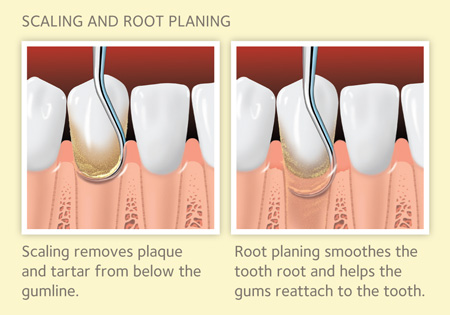Nearly half of adults over the age of 30 will be told by their dentist at some point that their teeth need a “deep cleaning.” Deep cleaning in this context refers to non-surgical periodontal therapy, more commonly known as scaling and root planing, or SRP.
Periodontal scaling and root planing are procedures used to remove plaque in the treatment of gum disease. According to the American Dental Association, roughly 47% of adults over 30 have a serious gum disease known as chronic periodontitis.
The procedure is more costly, more uncomfortable, and takes longer than a typical professional cleaning. It may be tempting to postpone or avoid it altogether. But the consequences can be serious. Advanced periodontitis can attack bone and connective tissue, requiring bone or tissue grafts. The disease is the main cause of tooth loss in adults.
When these dangers are a possibility, periodontal scaling and root planing is a necessary treatment.
Periodontal Disease Explained
Periodontal disease is better known as gum disease. Like tooth decay and cavities, it is caused by bacteria in the mouth that leads to a buildup of plaque. Plaque is a sticky substance that can eat away at tooth enamel if it isn’t cleaned off. Routine brushing and flossing can remove some plaque, and professional cleaning can usually take care of the rest.
Gum disease can result when plaque isn’t removed. In addition to poor oral care, other factors can contribute to periodontal disease. Smoking is one of the biggest risk factors. Diabetes can also increase the risk, as can some medications. Heredity plays a role too, making some people more susceptible.
The first stage of gum disease is gingivitis. It presents as irritation and inflammation of the gum tissue. Gums may be red and sore and might bleed during brushing and flossing. When gingivitis is caught early, it can often be reversed by improving dental hygiene habits, and thorough professional cleaning.
If gingivitis goes untreated, it can turn into periodontitis or more severe advanced periodontitis. Not only will gums be inflamed, but they will recede and pull away from the teeth. Receding gums leave gaps, or pockets, where additional bacteria and plaque can settle at the base of the teeth or on the roots.
A condition known as a calculus bridge can sometimes form too. This is when plaque, also called tartar, hardens into a solid mass at the gum line. In extreme cases, this “bridge” is all that is holding the teeth in place.
The Scaling and Root Planing Procedure

Anyone who has had a professional dental cleaning has had some scaling done to their teeth. When a dental hygienist uses a hand tool to scrape plaque off teeth, that’s scaling.
Periodontal scaling goes deeper than a typical cleaning. The scraping is done not only at the gum line, but below it, closer to the root. This more extensive procedure to remove hardened plaque and calculus is also called debridement.
The next step in the process is root planing. This involves smoothing the exposed surface of the roots after the plaque has been removed. This helps the gum tissue reattach to the root and tooth so healing can begin.
What to Expect from SRP Treatments
Scaling and root planing is performed by a dentist or a periodontist (gum disease specialist). They may use hand instruments called scalers or curettes, similar to those used by hygienists, or they may use ultrasonic tools.
The process takes longer and is more invasive than normal teeth cleaning so it may be performed in multiple visits. A typical protocol would be to divide the mouth into four quadrants: Two upper and two lower, with one quadrant being treated at each of four visits.
SRP treatments can be painful, so a local anesthetic is administered. After the treatment, patients will experience some pain and tenderness until the roots and gums heal. An antibiotic may be applied directly to the gums during the procedure or may be prescribed afterward to avoid infection.
The complexity of the process and the fact that a specialist may do it means that the cost will be higher than a professional cleaning. Dental insurance, however, will normally cover necessary scaling and root planing.
How is Periodontal Disease Diagnosed?
Irritated gums that bleed easily may be the first sign of periodontal disease. Other indicators may be chronic bad breath, loose teeth, or a change in the way the teeth fit together when biting down. But even before these symptoms appear, the disease may be detected during a regular dental checkup.
During professional cleanings and exams, a dental hygienist or dentist will use a small dental instrument called a periodontal probe to measure the pockets that develop when gums start to recede.
Normal, healthy pockets will typically be between 1 and 3 mm deep. Better brushing and flossing will usually be recommended for 3 mm pockets. Pockets are 4 mm or more, indicated gingivitis or periodontitis and the dentist may recommend scaling and root planing.
SRP: A Necessary Treatment for Periodontal Disease
Gingivitis can be reversed if it is not too advanced. Once it has progressed to periodontitis, there is no cure. The disease can, however, be treated with periodontal scaling and root planing.
More importantly, gum disease is preventable. Maintain good oral care, stop smoking, and keep an eye on other factors that can increase plaque buildup. Schedule regular dental visits, or find a dentist with our online tool.
Being proactive about your dental health can decrease your chances of ever needing periodontal therapy.


